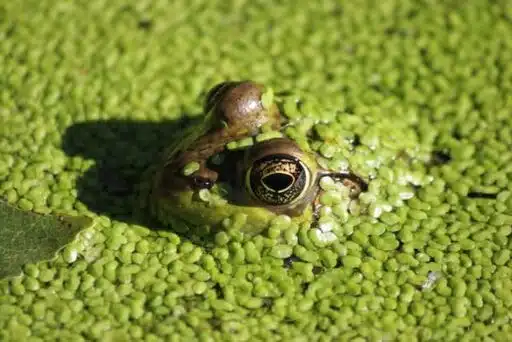The frog is one of the ecosystem’s most abundant and widespread amphibians. Their bodies are slumped, and their skin is damp – features that most people are familiar with. But do you know what frog poop looks like? Read below to find out.
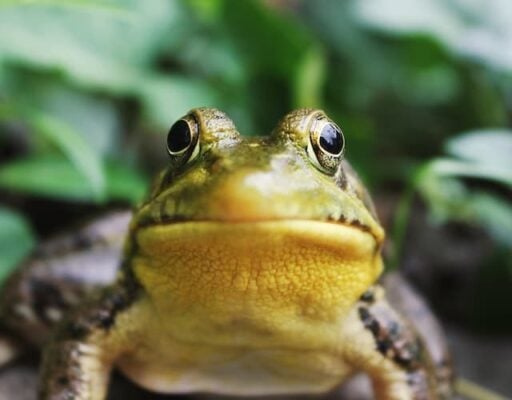
Frogs consume a lot of food during the day, which is why they need to poop to eliminate waste materials.
Frog poop is brown with a cylindrical structure, it can be moist or wet and can be found in complete portions or smaller bits. It can also be found as a pile of less solid dark brown or black material.
How Do Frogs Poop?
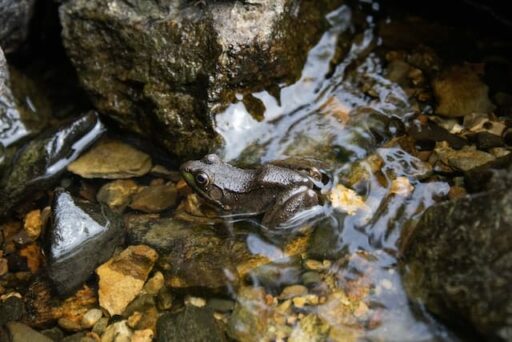
Amphibians, like frogs, discharge waste through the cloaca opening. The cloaca is a single aperture that connects the digestive, urinary, and reproductive systems. It releases waste that is both liquid and solid in nature.
Dietary processes begin in the mouth. In their intricate digestive process, frogs have various adaptations that enable them to act quickly and efficiently. Until the meal is ejected as a stool, the tongue, saliva, and stomach all participate in the process.
If they don’t poop, frogs gain weight quickly and can become less active. Additionally, constipation can lead to breathing issues, which may result in death in severe cases.
How Often Do Frogs Poop?
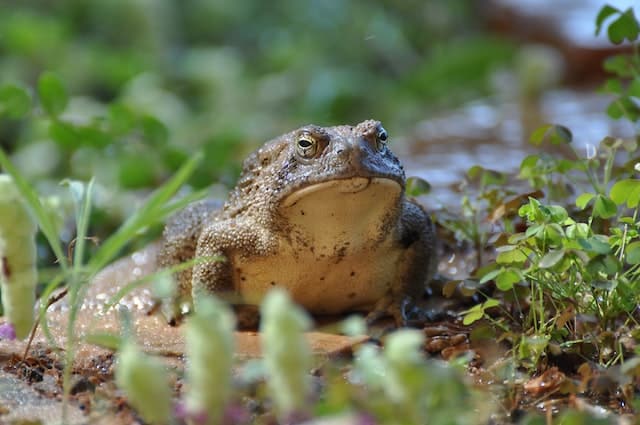
Pooping is an essential aspect of a frog’s health. However, they digest food somewhat slowly. They eat substantial meals made of chitin or bones. This indicates that frogs have quite strong stomachs.
So they do poop a lot, but not always as frequently as one may think. Adult frogs typically poop once every two to three days, and the change in frequency depends on the frog’s diet and digestion.
A smaller or younger frog will consume more food and consume it more quickly. A properly fed, extremely young frog can poop every day.
On the contrary, elderly frogs consume larger meals less frequently. Frogs’ appetite may also have an effect on how frequently they poop. More food will cause a frog to poop more frequently.
What Does Frog Poop Look Like?
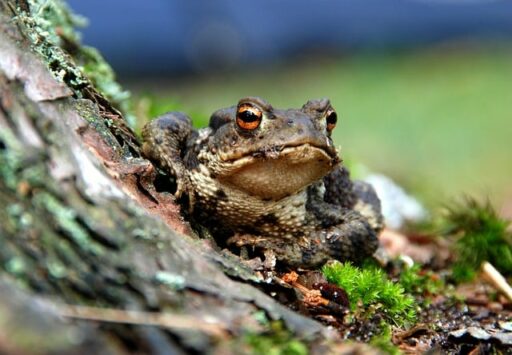
Usually, a frog’s poop is around one-fourth the size of its body. For feces, this is huge. A very dark brown to black color characterizes freshly expelled frog excrement. It seems to have a slick appearance. However, it quickly dries up, which causes it to lose a lot of its shine and silkiness.
A change in food may cause a change in poop color. This isn’t necessarily a symptom of being unwell. Sometimes it turns red. This is nothing to worry about, it’s simply the outcome of a dietary change.
Furthermore, hydration also affects the consistency and color of the poop.
Does Frog Poop Have a Smell?
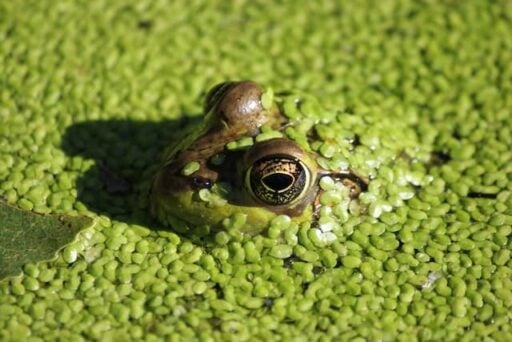
Like any other animal’s dung, frog poop also has a smell. It has a faint dog-poop odor with the same pungent smell as any other pet’s poop.
Make sure to clean out their cages to reduce the unpleasant odor regularly. This will stop waste from accumulating inside the cage. Additionally, it lessens the unpleasant odors that go along with it.
You shouldn’t be concerned if your frog’s excrement smells unusually foul. Frogs are healthy as long as they routinely eat and poop.
However, one should still observe how the color changes and how the poop smells. Usually, these indicators are normal – but in some cases they might indicate health problems. In such a scenario, a skilled veterinarian should be able to manage them with ease.
How Come a Frog’s Poop is So Big?
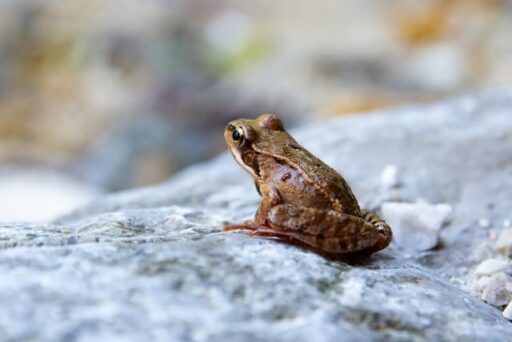
As we all know, frog poop is typically very big. This is because frogs eat more than is necessary for their size.
Also, frogs’ stomachs are rather large for them and they often consume enough food to fill them. The amount of food they consume at once may even cause their body size to increase.
When they get a meal, they will eat it all at once, primarily due to the uncertainty of when they’ll be able to find their next meal.
In addition, other predators can also approach and take their meal; consequently, they gulp down as much food as the stomach can contain. So it is only natural for them to produce a lot of waste after consuming so much food.
Why is Pooping Essential for Frogs?
Frogs can eliminate food waste from their body through poop. Frogs who don’t poop gain weight fast, and slow down in activity.
You will be amazed to know that frog bodies have a large capacity for fat storage, which helps them survive longer.
Frogs may develop health concerns such as breathing issues as a result of constipation. Prolonged constipation may eventually tear the intestinal wall, which would be fatal.
Constipation in captive frogs is often due to gastrointestinal impaction. It frequently happens as a result of ingesting non-food things like sand or moss. Consult a professional exotics vet as soon as possible if your pet frog isn’t pooping.
Where Do Frogs Poop?

Naturally, there is a possibility of finding frog poop anyplace. Bodies of water are where the frog prefers to reside, so naturally this is the most common place where you would come across it. Typically frog poop can be found:
- Near pools.
- Within and close to a pond or lake’s margins.
- The nearby moist and wet portions of your garden.
- In the aquarium.
But these aren’t the only sites where you might come across frog waste. For instance, it may be at window sills, door edges, etc. At night, there is a higher probability that frog food will be accessible. Moreover, it is more common to find frog poop in well-lit places.
Is Frog Poop Dangerous?
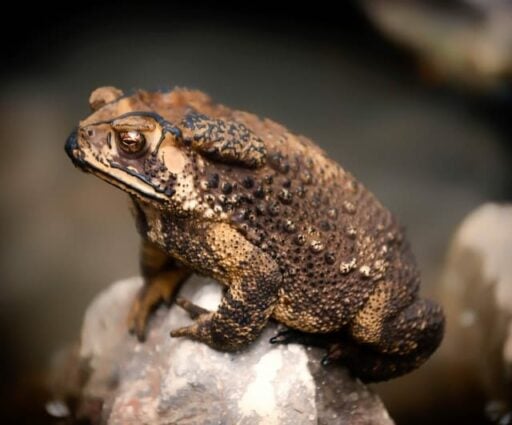
Humans are hardly ever at risk from frog poop. It does not directly cause any serious harm. However, you should proceed with caution.
Hazardous germs and parasites may be present in frog poop, and getting close to them could have an adverse impact. Furthermore, the pathogen that causes food poisoning is salmonella. In frog excrement, there is one of these pathogenic bacteria.
Infections with salmonella can result in severe flu-like symptoms. You may feel sick, have diarrhea, and have a fever. Another potential risk is the possibility of catching pinworms. Pinworm may stick itself to you if it comes into touch with you.
Pinworms are a prevalent parasite that can infect people and amphibians. Additionally, this parasite results in more infections than any other worm species.
Types of Frog Poops on the Basis of Frog Type:
#1 Tree Frogs Poop
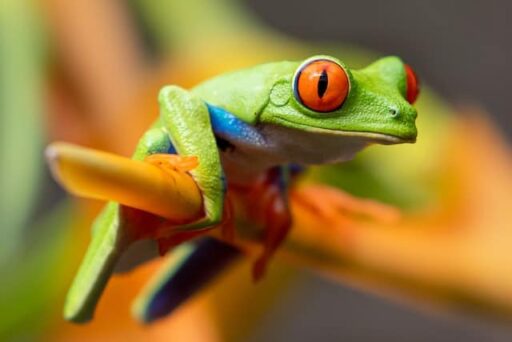
Knowing how frequently tree frogs poop is essential if you keep them as pets. Like most animals, tree frogs make one big poop every two to three weeks. Moreover, it varies on the animal’s species, age, diet, and size. These factors can all affect how frequently they poop.
Small tree frogs are under one inch in length. Some of the more important members are taller than five inches. But not all tree frogs are suitable as pets.
A one-inch frog will produce more infrequent, small droppings. This is more than what a big size animal can excrete.
#2 White Tree Frogs Poop
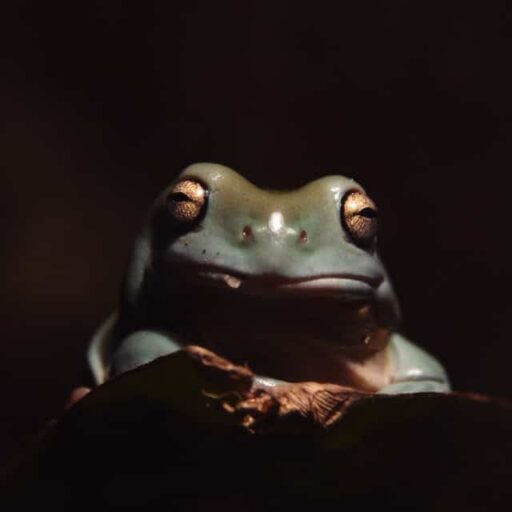
When they are young, white tree frogs poop every day or two. They eventually eat larger meals and poop less frequently. However, you should spot-clean their habitat on the daily. Since the species are fragile in nature, Tree frogs in white make wonderful pets.
However, you must keep an eye on their excrement. White tree frogs are popular due to their nature.
It’s essential to only provide white tree frogs with a balanced diet of food. These snackers will consume far more than they require if given a chance.
It also entails more poop and a greater chance of injury. If they experience constipation, give them a daily dip in some warm, dechlorinated water.
#3 Pacman Frogs Poop
It is among the most well-liked frogs to keep as pets, and they are popular because of their horns and vibrant colors. Moreover, most adult Pacman frogs only poop once every two to four weeks. If they are healthy and eating correctly, this is normal behavior.
Many amphibian experts advise feeding your Pacman powder roaches and crickets first. From then onwards they may consume a wide variety of meals, including mealworms. The biggest Pacman frogs can grow to be nearly six inches long.
#4 Baby Pacman Frogs Poop
The young Pacman frogs are really cute. However, babies require significantly more care than they do as adults. A newborn Pacman will eat every day and go poop every few days. Fortunately, the smaller frog will consume fewer calories and poop less.
The majority of young Pacman frogs are eager eaters, but they don’t bother their owners.
If your Pacman isn’t pooping as it should, give them a bath in lukewarm water with a few drops of honey since it has laxative properties.
How Long Can Frogs Go Without Pooping?
Your frog must poop as frequently as its body requires. Unluckily, a frog with impacted bowels can become sick very quickly – which can be fatal if the bowel ruptures.
When your pet is restless, it won’t eat or poop. Some animals can make predictions for up to ten months of the year. Others only do so briefly throughout the winter. Therefore, in case of any pooping-related problem, consult a good vet in a timely manner.
How does Frog Poop Differ From Other Amphibians?
Frog Poop vs Toad Poop
Frogs and toads have a close relationship, much like beans in a pod. As a result, it is challenging for the casual observer to differentiate them.
Additionally, most species of toads are larger than most species of frogs. They also have greater poop as a result. Due to the close kinship between toads and frogs, their poop is extremely similar. The size is usually what sets toad poop apart from frog poop.
Moreover, like frogs, toads eat a lot of food at once. They behave this way because they don’t know when their next meal will be. Because they eat so much, they must also defecate a lot.
Toads can produce massive amounts of feces, just like frogs can. So they release a lot of trash every day without feeling any discomfort.
Frog Poop vs Rat Poop
Both rat and frog poop include pathogens like worms. Rats, in contrast to frogs, can also infest homes. As a result, they could turn into a constant nuisance and inconvenience.
Rat and frog poop can resemble one another quite a bit. Rat excretions are typically cylinder-shaped and around 3/4 inches in length. Furthermore, they could taper at one end or both.
When fresh, they range from brown to black. But as time passes, they turn gray. Rats frequently leave behind a lot of waste in an area.
Additionally, rats poop more frequently than frogs do. A high concentration of droppings indicates rodent poop rather than frog poop. Rat poop is larger than frog poop, although this varies according depending on the species.
Frog Poop vs Snake Poop
The appearance of snake and frog poop is very different. More often than frogs, snakes prefer to leave a slimy mess.
Typically, snake poop will have some white or yellow spikes on it. This chemical is known as urea. It resembles pee, more or less in a reptile. Despite being moist, frog poop is typically extremely solid.
The poop from snakes is far more liquid. Moreover, it frequently contains tiny bones from its prey.
If you frequently discover droppings, it’s more likely to be frog or toad feces than snake droppings. This is due to how long snakes go between meals. Therefore, they do not poop very frequently.
Tips to Prevent Frogs From Pooping on your Porch
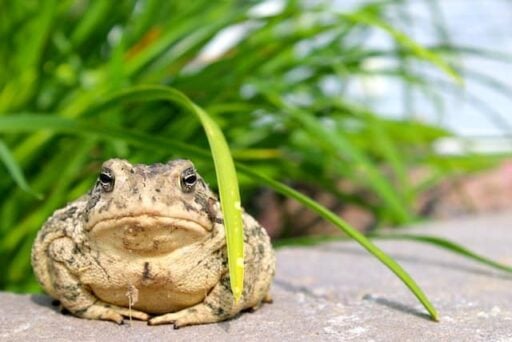
Turn off the Lights on the Porch
Turning off your porch lights is the most obvious solution. Limit night-time use of additional outside lighting.
In the unlit area, you will see a dramatic decrease in the insect population. Therefore, the neighborhood frogs won’t find your porch as tempting. Also, pay attention to the lights within your home.
Consider putting up light-blocking curtains to keep the porch from being lit up. Place a modest light at the farthest corner of your yard if it is unusually large. It will entice frogs and insects away from your home.
However, avoid using this technique for a long period of time, as the frogs will probably continue gathering in your property area on that site.
Clear your Yard of any Open Water
Almost invariably, a pond will draw additional frogs to your yard. So, if the frogs are really bothering you, you might want to remove your pond.
You might also drain the pond for a few weeks to keep the frogs away. This method is not long-lasting, but it allows you to determine whether eliminating the open water source will resolve your frog issue. Certain yards are at a lower altitude.
After a significant downpour, your yard can have standing water. You might want to modify the water flow on your land. Frogs find standing water to be extremely appealing. However, it can harm your house as well.
Prune the Plants
Transform your porch from a jungle to a clean space. Trim any huge, stray shrubs. Furthermore, think about removing any unnecessary flora.
By doing this, there will be less habitat available for the local frogs. Moreover, the frogs will travel to your porch with more exposure which will be riskier and will deter them from approaching your porch.
Put Up a Fence Around Your Porch
Barricading your porch is a simple solution to keep frogs out of the area. Start by searching the porch and then uncover the locations where frogs appear to be pooping most frequently.
The next step is to choose a fence material that fits your porch’s design. You can use any design that will stop the entry points.
If you want to do this, be sure to tell your family. Nobody should trip over the barricade, of course. Once your barricade is set up, keep a close eye on everything. Check on it at night to see if it’s operating properly.
Additionally, adjusting the placement might be necessary. If the frogs persist in entering, alter the material.
Use Vinegar
Many individuals use vinegar as an insect and frog repellent. A spray bottle, or cloth is also okay,
to spread the vinegar around your porch. A frog experiences stinging on its skin when it walks on the vinegar. Frogs find it disturbing and offensive and hate how vinegar makes them feel.
It is important to note that it is unpleasant but not poisonous to frogs. Apply the vinegar to the spots where frogs frequently enter your porch. This method of spreading vinegar can also keep insects away.
Wrapping Up
Frogs consume a lot of food. It’s because they are uncertain about the availability of their next meal. As a result, their stomach fills up with all that food. So, in order to finally get rid of the waste, they discharge it through pooping.
Frog poop’s size is what makes it most interesting. In comparison to the size of the frog, its poop is fairly huge. Its surface is shiny and black or dark brown in color. The size and appearance of frog excrement are what make it an unusual thing.
Thank you for reading this article! Continue discovering new facts about amphibians here: the 19 Most Endangered Amphibians.
Join our Forum for free today!


